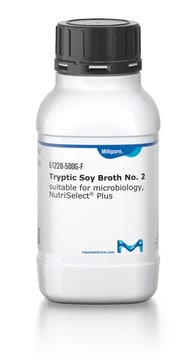22092
Tryptic Soy Broth - Dehydrated Culture Media
NutriSelect® Plus, powder, suitable for microbiology
Synonym(s):
CASO Broth, Soybean Casein digest Broth, TSB, Tryptone Soy Broth, CASO Broth, Casein Soya Broth, Soybean Casein digest Broth, TSB, Tryptone Soya Broth
About This Item
Recommended Products
Agency
according to ISO 10273:2017
according to ISO 21871:2006
Quality Level
sterility
non-sterile
form
powder
shelf life
limited shelf life, expiry date on the label
composition
casein peptone (pancreatic), 17 g/L
dipotassium hydrogen phosphate, 2.5 g/L
glucose, 2.5 g/L
sodium chloride, 5 g/L
soya peptone (papain digest.), 3 g/L
packaging
bottle of 500 g
manufacturer/tradename
NutriSelect® Plus
technique(s)
microbiological culture: suitable
color
light yellow
final pH
7.3±0.2 (25 °C)
application(s)
bioburden testing
cleaning products
clinical testing
cosmetics
environmental
food and beverages
pathogen testing
personal care
pharmaceutical
sample preparation
veterinary
water monitoring
microbiology
suitability
nonselective for Bacillus spp.
nonselective for Bacteroides spp.
nonselective for Campylobacter spp.
nonselective for Candida spp.
nonselective for Escherichia coli
nonselective for Neisseria spp.
nonselective for Staphylococcus spp.
nonselective for Streptococcus spp.
nonselective for bacteria (General Media)
nonselective for coliforms
Looking for similar products? Visit Product Comparison Guide
General description
Application
Features and Benefits
- Quality control with growth promotion test according to industry standards
- Quality assurance acc. to ISO 9001
- Cost-efficient powdered media
Preparation Note
Other Notes
Footnote
The designations basic, plus, or prime are added to indicate the quality control level, from basic quality control to standard QC plus to prime for full regulatory compliance.
Legal Information
Storage Class Code
11 - Combustible Solids
WGK
WGK 1
Flash Point(F)
Not applicable
Flash Point(C)
Not applicable
Personal Protective Equipment
Choose from one of the most recent versions:
Already Own This Product?
Find documentation for the products that you have recently purchased in the Document Library.
Customers Also Viewed
Our team of scientists has experience in all areas of research including Life Science, Material Science, Chemical Synthesis, Chromatography, Analytical and many others.
Contact Technical Service












